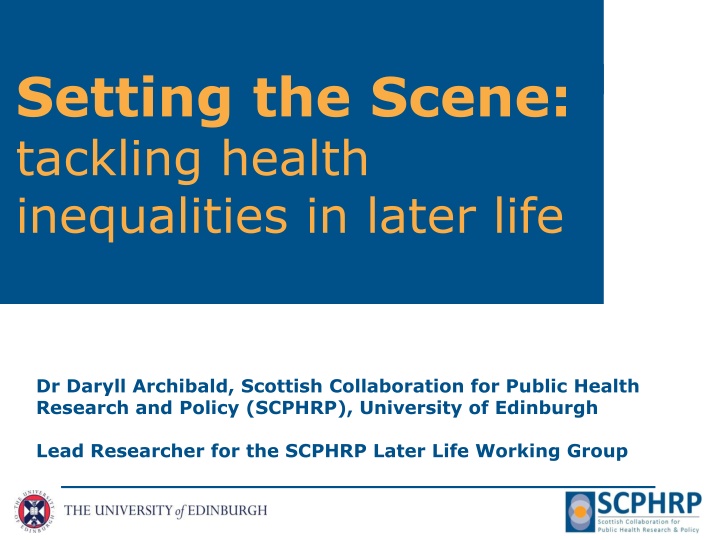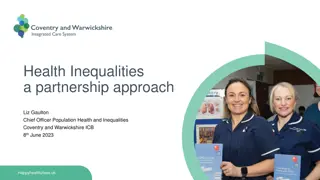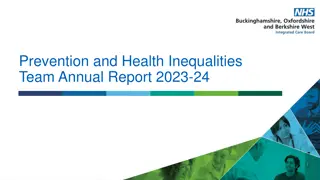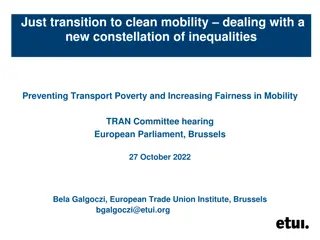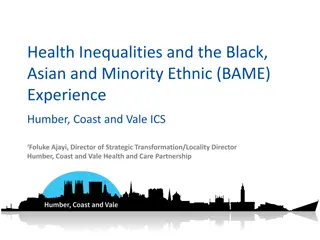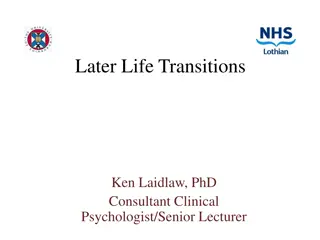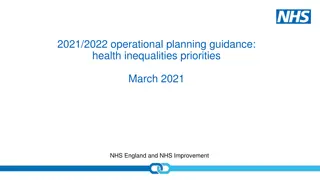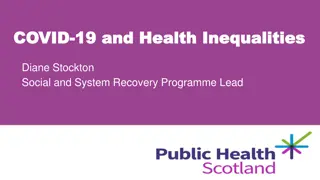Setting the Scene: tackling health inequalities in later life
Dr. Daryll Archibald, a lead researcher at SCPHRP, University of Edinburgh, heads the Later Life Working Group, focusing on addressing health inequalities in later stages of life. This research initiative aims to identify, understand, and address factors contributing to disparities in health outcomes among older populations, ultimately striving to enhance overall well-being and quality of life for the elderly.
Download Presentation

Please find below an Image/Link to download the presentation.
The content on the website is provided AS IS for your information and personal use only. It may not be sold, licensed, or shared on other websites without obtaining consent from the author.If you encounter any issues during the download, it is possible that the publisher has removed the file from their server.
You are allowed to download the files provided on this website for personal or commercial use, subject to the condition that they are used lawfully. All files are the property of their respective owners.
The content on the website is provided AS IS for your information and personal use only. It may not be sold, licensed, or shared on other websites without obtaining consent from the author.
E N D
Presentation Transcript
Setting the Scene: tackling health inequalities in later life Dr Daryll Archibald, Scottish Collaboration for Public Health Research and Policy (SCPHRP), University of Edinburgh Lead Researcher for the SCPHRP Later Life Working Group
Presentation Outline 1. The basics: what are health inequalities? 2. What factors explain the existence of health inequalities? 3. Broad issues around health inequalities in later life. 4. Predictors of poor health in later life. 5. The importance of social networks for health inequalities in later life. 6. How have social isolation and loneliness been tackled? 7. Conclusion.
The basics: what are health inequalities? Health inequalities are differences in health status or in the distribution of health determinants between different population groups. For example: differences in mobility between elderly people and younger populations. differences in mortality rates between people from different social classes.
The basics: what are health inequalities? It is important to distinguish between inequality in health and inequity. Some health inequalities are: Attributable to biological variations or free choice. Changing health determinants in these cases may be impossible or ethically or ideologically unacceptable so these health inequalities are unavoidable.
The basics: what are health inequalities? Others are: Attributable to the external environment and conditions mainly outside the control of individuals. Uneven distribution in health outcomes in this case may be unnecessary and avoidable and the resulting health inequalities also lead to inequity in health. Differences in rates of illness and health affect everyone: health and socio-economic status diminish continually along the social gradient in health.
What explains the existence of health inequalities? Material deprivation? the graded relation between socioeconomic position and access to tangible material conditions, from basics such as food, shelter, and access to services and amenities, as well as car and home ownership, access to telephones and the internet...
What explains the existence of health inequalities? Psychosocial factors? the direct or indirect effects of stress stemming from either being lower on the socioeconomic gradient, or living under conditions of relative socioeconomic disadvantage.
What explains the existence of health inequalities? Answer: both! All material resources of some relevance to daily life have some psychosocial meaning attached to it. For example, home or car ownership has both a material interpretation and a psychosocial one (as in the symbolic sense of security that home or car ownership affords).
Health inequalities in later life Relatively little research has been carried out to investigate health inequalities at older ages. Key debate: Whether socio-economic differences in mortality and health found at younger ages persist in later life?
Health inequalities in later life Social inequalities in health persist at older ages and, as at younger ages, these inequalities have widened over time. There has been an increase in the gap in life expectancy at age 65 between Social Classes I and V. In the UK socio-economic class I can expect to live an additional 17.5 years once they reach the age of 65, while those in social class V can expect to live only another 13.4 years. The importance of socio-economic status and inequality in the UK therefore has profound implications for health in later life just as it does in all other age groups.
Factors leading to health inequalities in later life Research examining circumstances in childhood and in adulthood has shown the continued impact of childhood factors, such as father s social class, on later life health. However, current circumstances such as health and socio-economic status appear to have greater influence on health outcomes. Early age at retirement and experiencing a job loss are also associated with poorer physical, and in some cases, mental health in mid and later life. More time spent unemployed is generally associated with poorer health, as is working life spent in low control jobs or in passive jobs. Life-long economic hardship is also associated with worse health outcomes in later life.
The significance of social support in later life Social support is a key dimension of well-being at older ages. This encompasses: (i) social network characteristics, (ii) social embeddedness such as the frequency of contact with others, (iii) emotional assistance, reflecting current and future availability of emotional support, and (iv) instrumental assistance (transfers of space, time, and money) from family, friends, neighbours and other community members.
Social Networks & Social Embededdness Policy concentration on how these issues affect older people. Older people are particularly vulnerable to social isolation or loneliness owing to loss of friends and family, mobility or income. Social isolation and loneliness impact upon individuals quality of life and wellbeing, adversely affecting health and increasing their use of health and social care services. Epidemiological studies clearly demonstrate links between inequality, poor social networks and ill health.
Tackling social isolation and loneliness in later life Interventions to tackle social isolation or loneliness include: befriending, mentoring, Community Navigators and social group schemes. People who use befriending or Community Navigator services report they are less lonely and socially isolated following these interventions. The outcomes from mentoring services are less clear; some improvements in mental and physical health reported, however other studies have found no difference.
Tackling social isolation and loneliness in later life Where longitudinal studies have recorded survival rates, older people who have taken part in a social group intervention have been found to have a greater chance of survival than those who had not received such a service. Users report high satisfaction with such services and benefit by increasing their social interaction and community involvement. e.g. taking up or going back to hobbies and participating in wider community activities through voluntary work.
Tackling social isolation and loneliness in later life When planning services to reduce social isolation or loneliness, strong partnership arrangements need to be in place between organisations to ensure developed services can be sustained. There is a need to invest in proven projects. Community Navigator interventions have been shown to be effective in identifying those individuals who are socially isolated. Research needs to be carried out on interventions that include different genders, populations and localities. There is an significant need for more longitudinal, randomised controlled trials that incorporate standardised quality-of-life and cost measures.
Conclusions Ageing well is a 21st century challenge for global populations. Population ageing is often discussed in terms of risk and problems posed by demographic challenges, with limited discussion and understanding about benefits and opportunities. The key challenge is to understand how the population can age whilst flourishing and remaining as healthy as possible. However ...
Conclusions It is crucial that particular attention is given to helping people from disadvantaged social classes to achieve the good health that is attained by more advantaged groups in order to reduce need and tackle health inequalities among elderly people as the population ages.
Thank You Follow us on Twitter: @SCPHRP YouTube: youtube.com/scphrp1 Webpage: http://www.scphrp.ac.uk/
